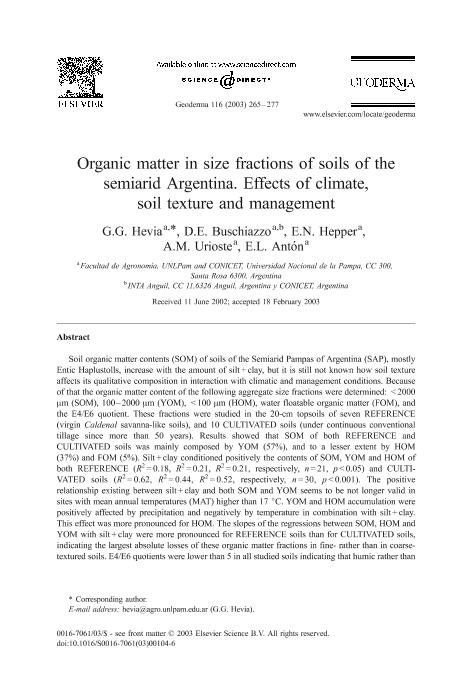Artículo
Organic matter in size fractions of soils of the semiarid Argentina. Effects of climate, soil texture and management
Hevia, Graciela Gloria; Buschiazzo, Daniel Eduardo ; Hepper, Estela Noemí; Ana María, Urioste; Antón, E. L.
; Hepper, Estela Noemí; Ana María, Urioste; Antón, E. L.
 ; Hepper, Estela Noemí; Ana María, Urioste; Antón, E. L.
; Hepper, Estela Noemí; Ana María, Urioste; Antón, E. L.
Fecha de publicación:
02/2003
Editorial:
Elsevier Science
Revista:
Geoderma
ISSN:
0016-7061
Idioma:
Inglés
Tipo de recurso:
Artículo publicado
Clasificación temática:
Resumen
Soil organic matter contents (SOM) of soils of the Semiarid Pampas of Argentina (SAP), mostly Entic Haplustolls, increase with the amount of silt+clay, but it is still not known how soil texture affects its qualitative composition in interaction with climatic and management conditions. Because of that the organic matter content of the following aggregate size fractions were determined: <2000 μm (SOM), 100-2000 μm (YOM), <100 μm (HOM), water floatable organic matter (FOM), and the E4/E6 quotient. These fractions were studied in the 20-cm topsoils of seven REFERENCE (virgin Caldenal savanna-like soils), and 10 CULTIVATED soils (under continuous conventional tillage since more than 50 years). Results showed that SOM of both REFERENCE and CULTIVATED soils was mainly composed by YOM (57%), and to a lesser extent by HOM (37%) and FOM (5%). Silt+clay conditioned positively the contents of SOM, YOM and HOM of both REFERENCE (R2=0.18, R2=0.21, R 2=0.21, respectively, n=21, p<0.05) and CULTIVATED soils (R 2=0.62, R2=0.44, R2=0.52, respectively, n=30, p<0.001). The positive relationship existing between silt+clay and both SOM and YOM seems to be not longer valid in sites with mean annual temperatures (MAT) higher than 17°C. YOM and HOM accumulation were positively affected by precipitation and negatively by temperature in combination with silt+clay. This effect was more pronounced for HOM. The slopes of the regressions between SOM, HOM and YOM with silt+clay were more pronounced for REFERENCE soils than for CULTIVATED soils, indicating the largest absolute losses of these organic matter fractions in fine- rather than in coarse-textured soils. E4/E6 quotients were lower than 5 in all studied soils indicating that humic rather than fulvic acids exist in the well humified organic fraction of the studied soils. Contents of FOM and E4/E6 values did not correlated with the climatic conditions nor with soil texture or management. Potential SOM losses can be larger in fine-textured soils (up to 54.3 Mg C ha-1) than in coarse-textured (up to 35.7 Mg C ha-1). Probable changes of soil texture by wind erosion will modify absolute contents of SOM, YOM and HOM, while modifications of temperature or rains regimes will affect HOM more.
Palabras clave:
Climate
,
Cultivation
,
Organic Matter
,
Semiarid Regions
,
Size Fractions
,
Soil Texture
Archivos asociados
Licencia
Identificadores
Colecciones
Articulos(INCITAP)
Articulos de INST.D/CS D/L/TIERRA Y AMBIENTALES D/L/PAMPA
Articulos de INST.D/CS D/L/TIERRA Y AMBIENTALES D/L/PAMPA
Citación
Hevia, Graciela Gloria; Buschiazzo, Daniel Eduardo; Hepper, Estela Noemí; Ana María, Urioste; Antón, E. L.; Organic matter in size fractions of soils of the semiarid Argentina. Effects of climate, soil texture and management; Elsevier Science; Geoderma; 116; 3-4; 2-2003; 265-277
Compartir
Altmétricas



